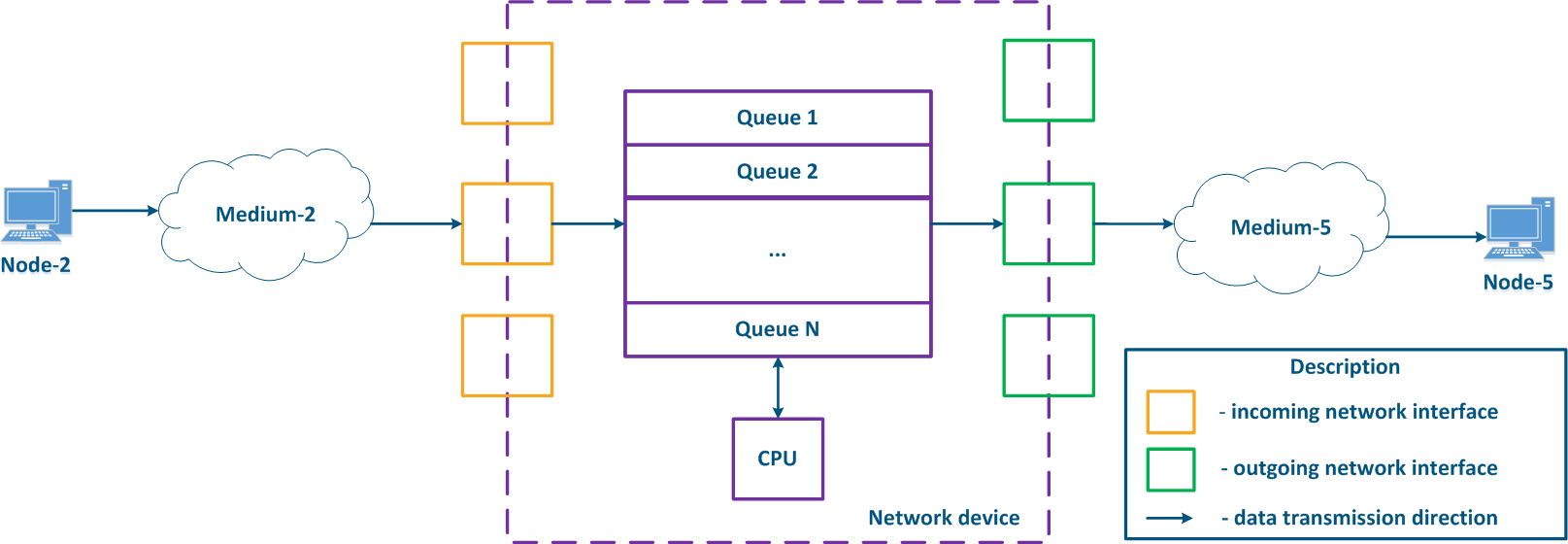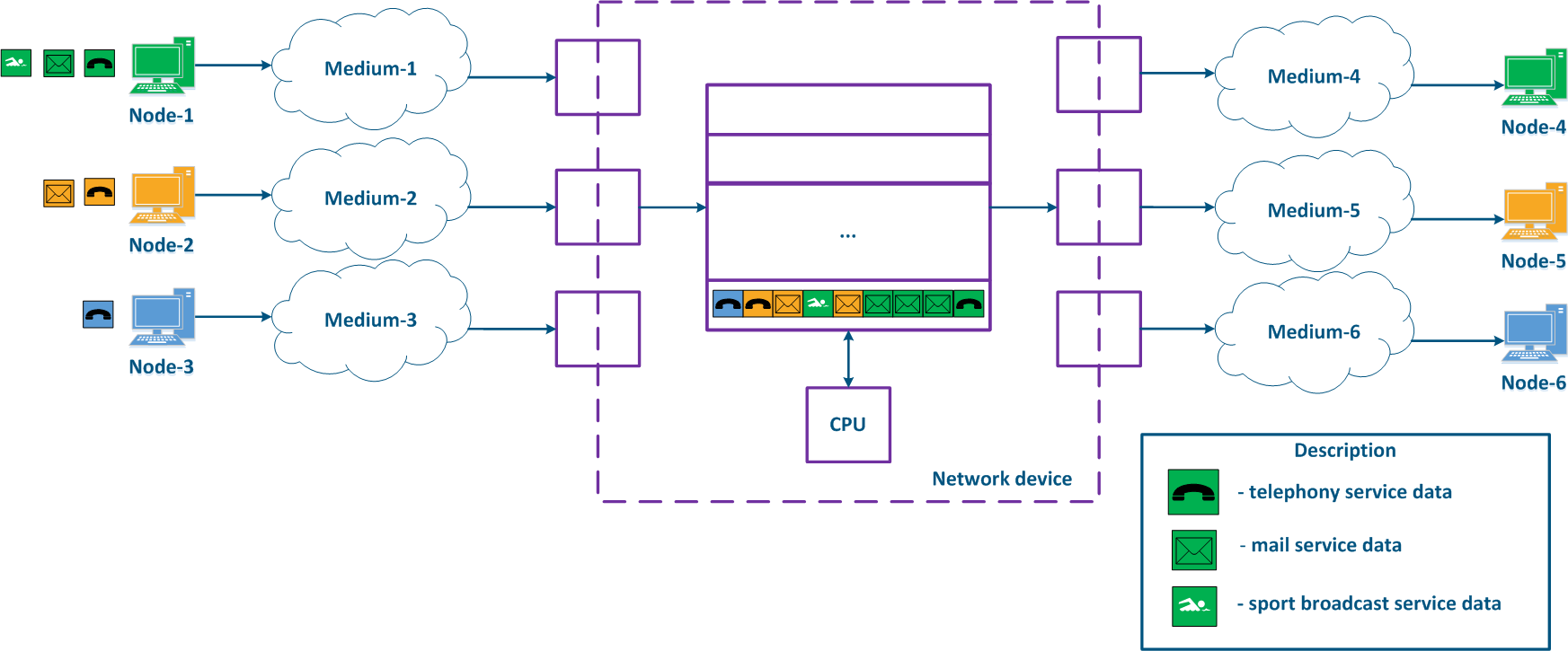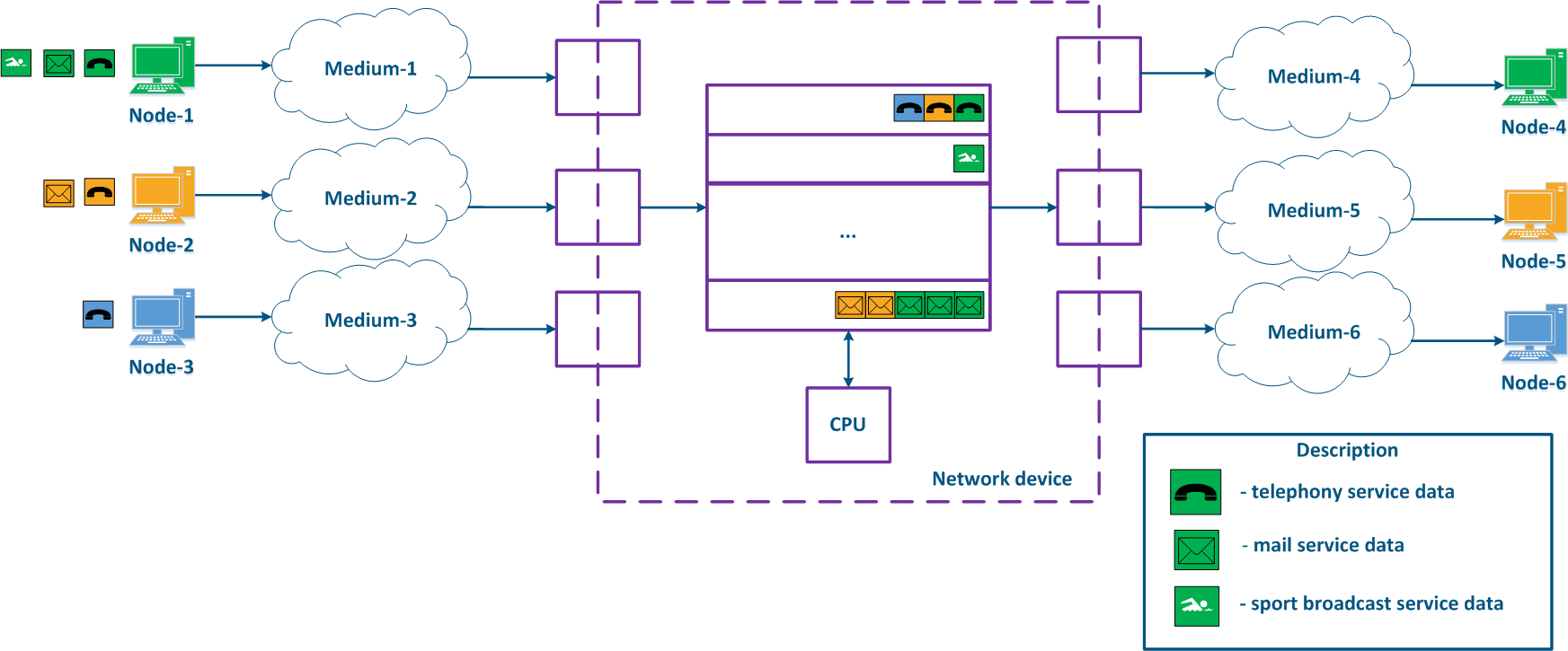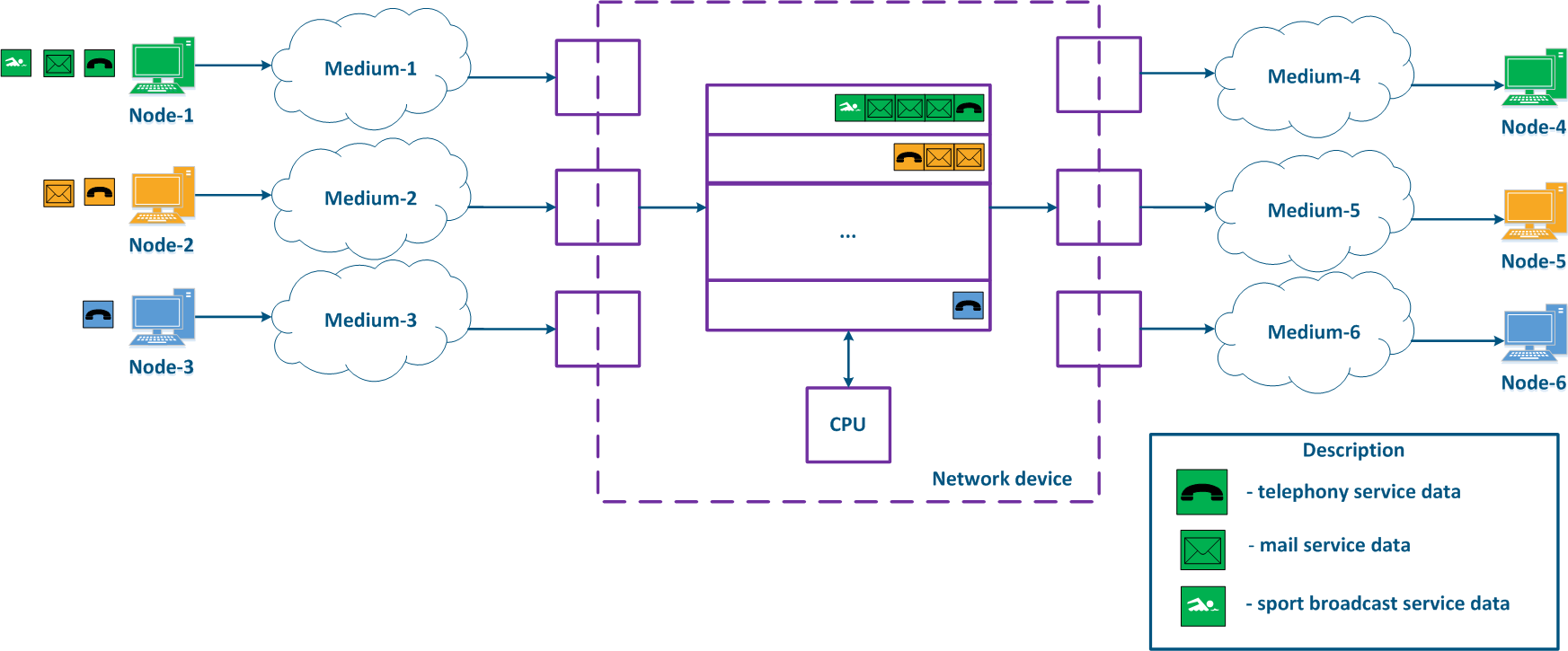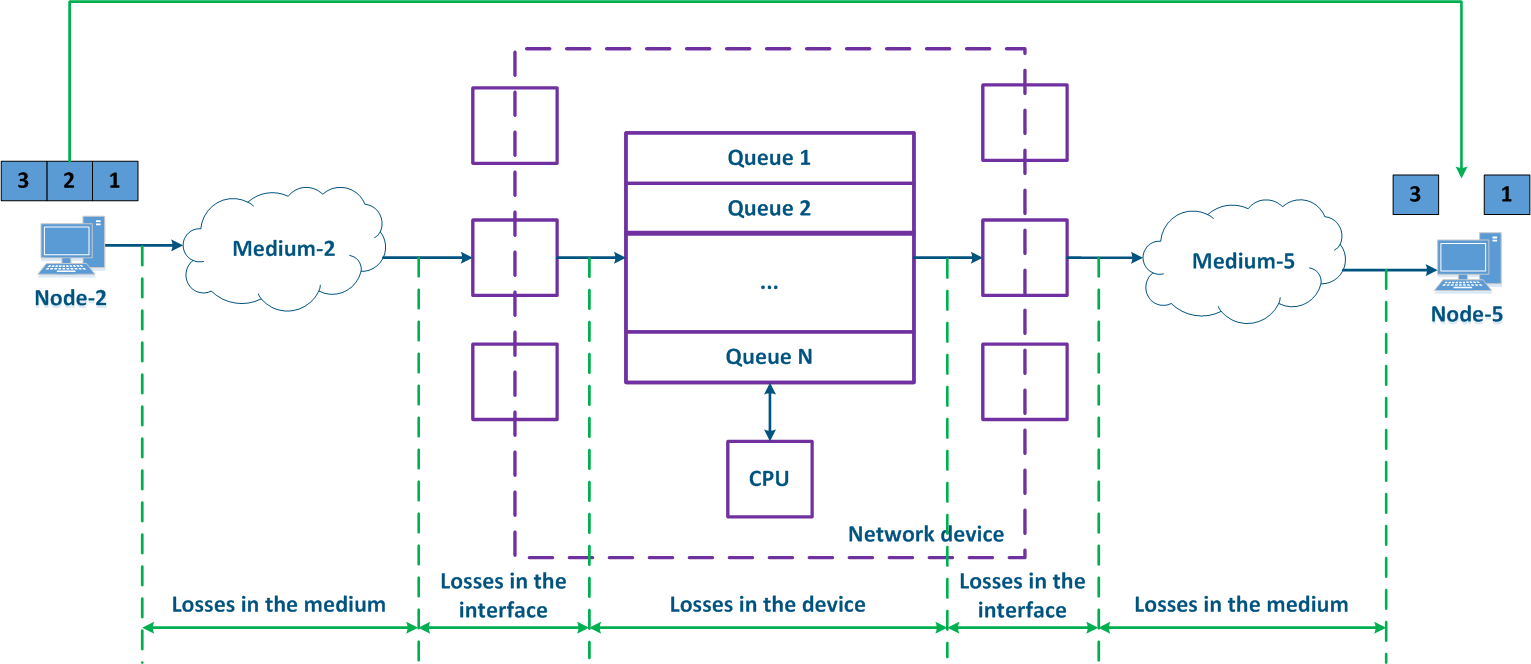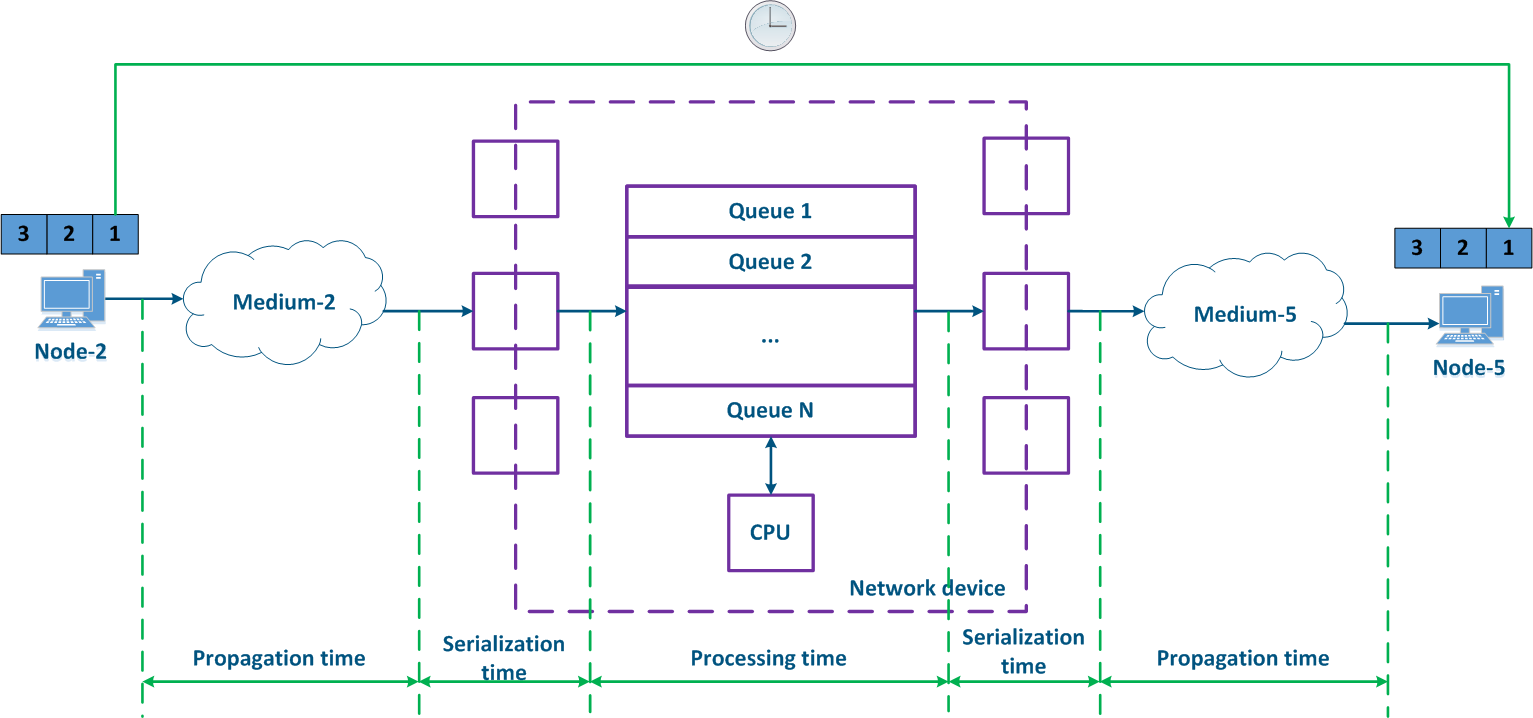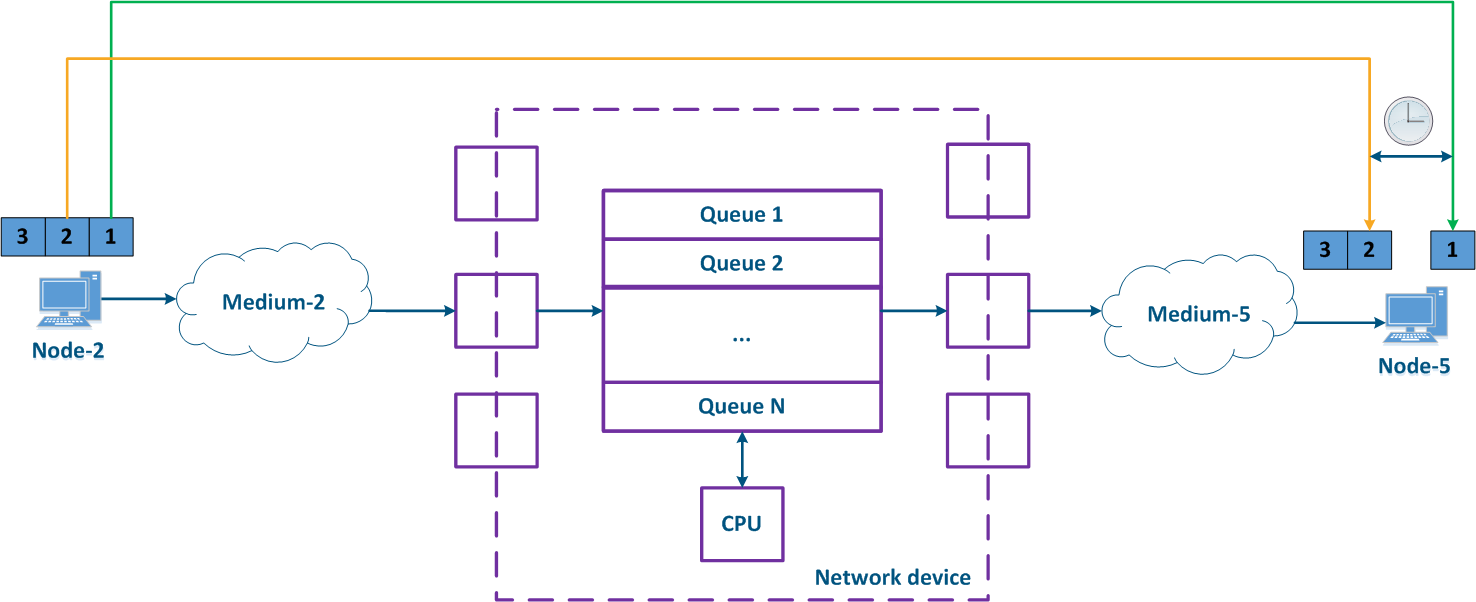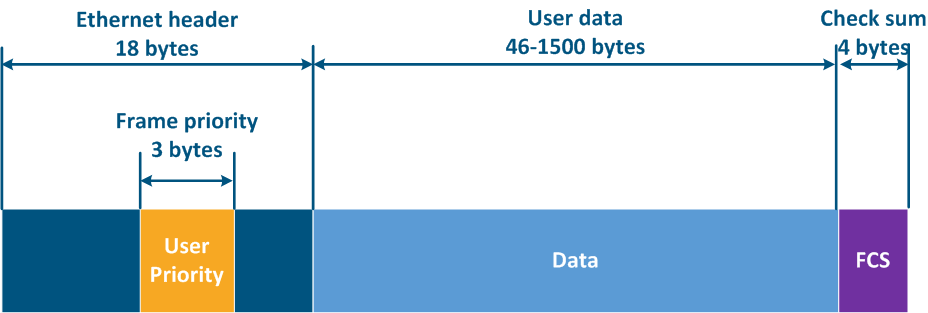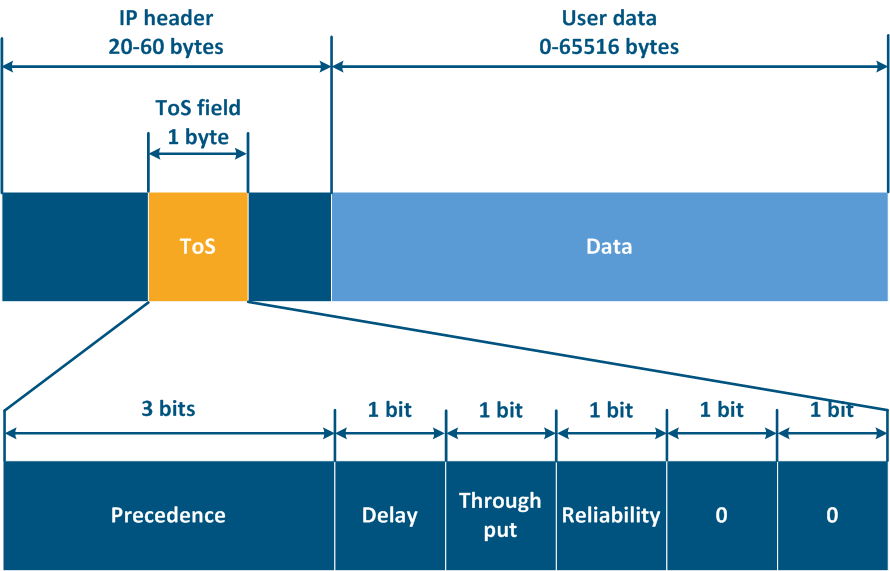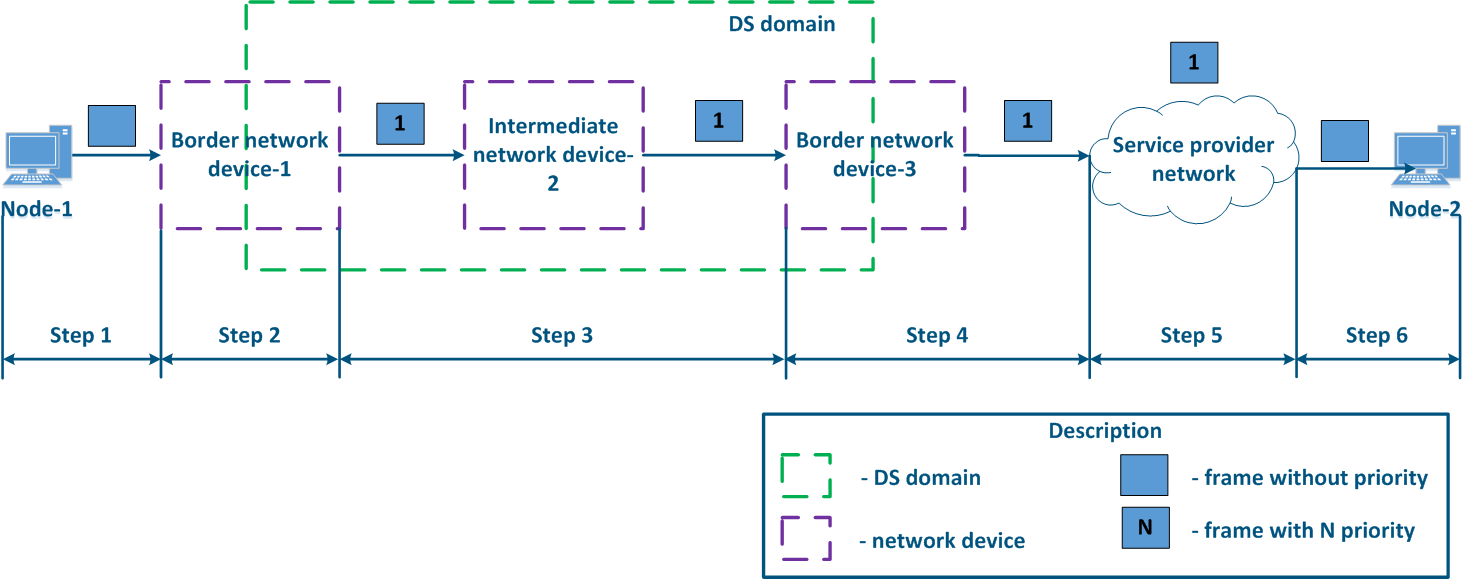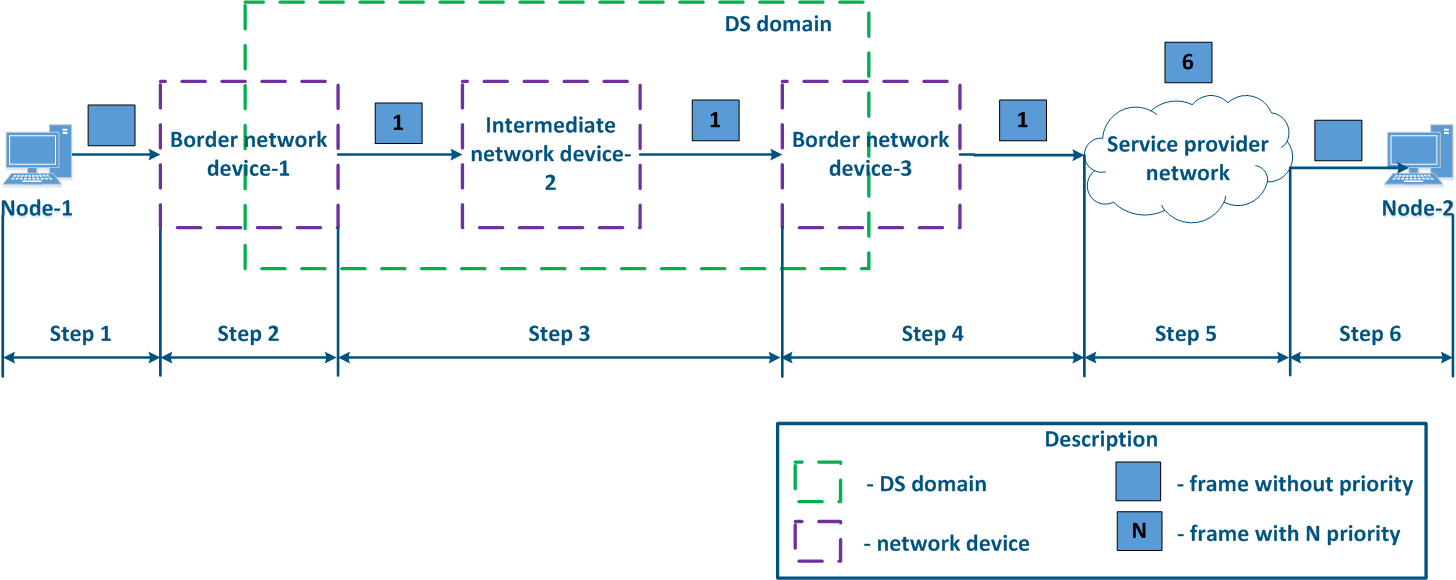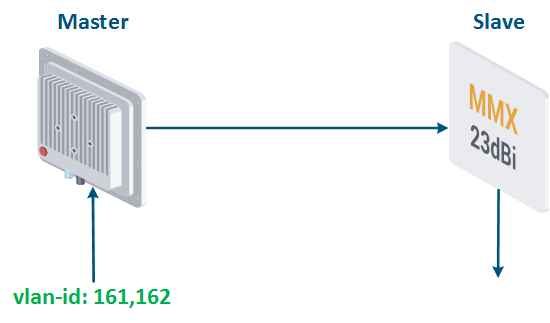Table of contents
| Table of Contentsinclude | ||||
|---|---|---|---|---|
|
| Table of Contents | ||||
|---|---|---|---|---|
|
...
The evolution of the data networks entails an increase in the volume of the transmitted traffic, which requires the usage of the a quality of service policy. The implementation of the policy will allow the classification of the network traffic and the distribution of the network resources between different traffic classes.
...
In packet networks, the traffic is transmitted from the sending node to the receiving node through communication channels and intermediate devices. Generally a data packet is processed by each intermediate device independently. Let's look at an example of data packet processing performed by an intermediate network device (Figure 1):
- Node-2 forms generates a data packet frame and transmits it to Medium-2. The data is encapsulated in a frame based on the L2-protocol that is used in Medium-2.
- The data frame is distributed in Medium-2. The : the frame is converted into a modulated signal according to the physical properties of the environment. The signals used in wired and wireless environments are different , so and this affects their propagation properties and their usage scenarios.
- The signal arrives at the incoming network interface of the intermediate network device; after demodulation, the received data frame is checked for integrity: the damaged frames are discarded.
- Next, the frame must be processed by the switching module in order to determine its path. If the frame is addressed to this intermediate network device, it will be passed for processing to the internal services. If the frame is addressed to another node, two scenarios are possible: the frame is passed to further processing until it reaches the output interface, or it is discarded (if Medium-2 is a common environment, where all signals will be received by all devices connected to the medium, according to the L2 protocol's operational principles, if the destination address in the frame's header does not belong to the device, then the device should discard it).
- In case that the frame should be processed and transferred to another node, before exiting the device it will be placed into a packet queue. A packet queue is a set of buffers that contain the data received by the incoming interfaces. The number and size of the memory buffers used for the packet queue storage are not standardized and depend on the equipment's manufacturer. For example, the InfiLINK 2x2 family of devices has 32 queues, 17 of which are available for configuration to the user.
- The data frame passes through the packet queue to which it was assigned and arrives at the outgoing interface.
- Since packet queues are a link between incoming and outgoing interfaces, a device should have a controller that fills the queues with the incoming data and picks data from the queues for transmission to the outgoing interfaces. Usually, these functions are performed by the central processing unit (CPU). As it will be shown below, the filling and the emptying of data into and from the queues can be performed unevenly and depends on the classification of the data streams.
- The outgoing interface generates a modulated signal and transmits it to Medium-5 which is connected to Node-5, the destination of the original data frame.
- Node-5 receives the signal, demodulates it , and processes the received data frame.
Note that in modern network devices, the network interfaces are usually combined and can operate both as incoming and outgoing.
| Center |
|---|
Figure 1 - Traffic passing through an intermediate network device |
A network device can be intermediate for several pairs of nodes , and each node can transmit the data of several services (Figure 2a). Let's look at the a scheme where the "Network device" is an intermediate node for the traffic coming from the following pairs of nodes: Node-1 - Node-4, Node-2 - Node-5 and Node-3 - Node-6. The first pair transmits data for three services, the second for two and the third for one service. If there are no QoS settings, the data of all services get through the general queue in the order they are received at the "Network device" and in the same order they will be transferred from the queue to the outgoing interfaces.
With QoS configured, each of the incoming traffic flows can be classified by its type (for example) and a separate queue can be mapped to each class (Figure 2b). Each packet queue can be assigned a priority, which will be taken into account while extracting the packets from the queues, and will guarantee specific quality indicators. The traffic flow classification can be performed not only with respect to the services used, but according to other criteria also. For example, each pair of nodes can be assigned to a separate packet queue (Figure 2c).
| Center |
|---|
Figure 2a - Queuing for various services without QoS Figure 2b - Queuing for various services with QoS Figure 2b - Queuing for various users with QoS |
Keep in mind that several intermediate network devices can be located on the data path between the source and the receiver, having independent packet queues, i.e. an effective QoS policy implementation will require the configuration of all the several network nodes.
| Anchor | ||||
|---|---|---|---|---|
|
...
- The throughput of the communication channel and of the network devices is limited.
- The data delivery time from source to destination is non-zero.
- A communication channel is a medium with a set of physical parameters that determine can have influence on the signal propagation effects.
- The software and hardware architecture of the network devices impacts the way in which the data is being transmitted.
...
During a data stream transmission, some packets may not be received, or may be received with errors. This process is called data loss , and it is defined as the ratio between the number of received packets and the number of transmit transmitted packets. In the example below (Figure 3), Node-2 transmits packets with the identifiers 1, 2 and 3, however, Node-5 receives only packets 1 and 3, i.e. the packet with the identifier 2 was lost. There are network mechanisms which allow the retransmission of the lost data. Examples of such mechanisms are the TCP and the ARQ protocols.
...
- Losses in the medium: losses related with the propagation of the signal in the physical environment. For example, the frame will be lost if the useful signal level is lower than the receiver sensitivity. Losses can also be caused by the physical damage of the interfaces connected to the media or by impulse pickups resulting from poor grounding.
- Losses on the interface: losses while processing a queue at the incoming or at the outgoing interface. Each interface has a memory buffer, which can be completely filled in case of intensive data stream transmissions. In this case, all the subsequent data entering the interface will be discarded, because it cannot be buffered.
- Losses inside the device: Data discarded by the network device according to the logic of the configuration. If the queues are full and the incoming data cannot be added to the processing queue, the network device will drop it. Also, these losses include the data packets rejected by access lists and by the firewall.
| Center |
|---|
Figure 3 - Data packet loss example |
Losses The losses affect two indicators: throughput and packet performance.
...
One of the main indicator that is practically used is the throughput, whose value depends on the losses. Throughput The throughput is defined by the capabilities of the physical 's channel capabilities and by the ability of the intermediate network devices to process the data stream. The link throughput is defined as the maximum amount of data that can be transmitted from the source to the receiver per unit of time.
...
Due to the limited amount of internal memory, better packet performance is achieved for the minimum frame size. Using minimum sized frames assumes a large amount of overhead amount since each data frame has a service header, whose size does not depend on the size of the frame itself.
For example, the service header length for 64 bytes long frames (Figure 4b) and 156 bytes frames(Figure 4c) will be the same, but the user data amount will be different. To transmit 138 bytes of user data, three 64 bytes frames or one 156 bytes frame will be required, so in the first case 192 bytes are sent, in the second only 156 bytes. For a link having a fixed throughput, large frames will increase the efficiency by rising the useful throughput of the system, but the latency will also increase. The performance of the Infinet devices in various conditions is shown in the "Performance of the InfiNet Infinet Wireless devices" document.
| Center |
|---|
Figure 4 - Frame structure for various Ethernet frame lengths |
...
Delay is defined as the time it takes for a packet to travel from the source to the destination. The value of the delay 's value depends on the following aspects:
- The signal's propagation duration in the medium: depends on the physical characteristics of the medium and it is nonzero
- Serialization time: the conversion of a bitstream to a signal and backward by the incoming/outgoing interfaces is not instantaneous and makes use of the hardware resources of the network device.
- Processing time: the time spent by the data packet inside the network device. This time depends on the status of the packet queue, as a data packet will be processed only after processing the packets placed earlier in this queue earlier.
The delay is often measured, as a round-trip time (RTT), i.e. the time it takes for the data packet to be transmitted from a the source to a the destination and backward. For example, this value can be seem seen in the ping command's results. The time it takes for the intermediate network devices to process the data packets forward and backward may differ, therefore, usually the round-trip time is not equal to the double of the one-way delay.
| Center |
|---|
Figure 5 - Example of data transfer delay |
Jitter
The CPU load and the status of the packet queues status are frequently changing at the intermediate network devices, so the delay during the data packet transmission will vary. In the example below (Figure 6), the transmission time for the packages packets with the identifiers 1 and 2 is different. The difference between the maximum and the average delay values is called jitter.
| Center |
|---|
Figure 6 - Example of varying delay in data transfer |
...
The effect depends on the characteristics of the service and on the ability of the higher layer network protocols to restore the original sequence. For example Usually, if the traffic of different services is transmitted through different paths, then it should not affect the ordering of the received data.
| Center |
|---|
Figure 7 - Example of unordered data delivery |
...
Each of the data transfer services has a set of requirements for the quality indicators. The RFC 4594 document includes the following service types:
| Center | |||||||||||||||||||||||||||||||||||||||||||||||||||||||
|---|---|---|---|---|---|---|---|---|---|---|---|---|---|---|---|---|---|---|---|---|---|---|---|---|---|---|---|---|---|---|---|---|---|---|---|---|---|---|---|---|---|---|---|---|---|---|---|---|---|---|---|---|---|---|---|
| |||||||||||||||||||||||||||||||||||||||||||||||||||||||
| Expand | |||||||||||||||||||||||||||||||||||||||||||||||||||
|---|---|---|---|---|---|---|---|---|---|---|---|---|---|---|---|---|---|---|---|---|---|---|---|---|---|---|---|---|---|---|---|---|---|---|---|---|---|---|---|---|---|---|---|---|---|---|---|---|---|---|---|
| |||||||||||||||||||||||||||||||||||||||||||||||||||
| |||||||||||||||||||||||||||||||||||||||||||||||||||
QoS methods
The traffic transmission of the various services is performed on a single network infrastructure, which has limited resources, therefore, mechanisms should be provided for distributing the resources between the services.
Let's look at the example below (Figure 8). Node-2 generates traffic serving different services with a total speed of 1 Gbit/s. Medium-2 allows to transfer this data stream to an intermediate network device, however, the maximum link throughput between the Network device and Node-5 is 500 Mbps. Obviously, the data stream cannot be processed completely and part of this stream must be dropped. The QoS task is to make these drops manageable in order to provide the required metric values for the end services. Of course, it is impossible to provide the required performance for all the services, as the throughput does not match, therefore, the QoS policy implementation involves that the traffic of the the critical services should be processed first.
| Center |
|---|
Figure 8 - Example of inconsistency between the incoming traffic amount and the link throughput |
The example above allows to highlight two Two main methods used during the QoS policy implementation can be highlighted:
- Prioritization: data distribution among the distribution of the data packets into queues and the extraction of the packets selection from the queues by their priority. In this case, the packets that are most sensitive to delay and jitter are processed first, then the traffic for which the delay value is not critical is processed.
- Throughput limitation: throughput limitation for the traffic flows. All the traffic that exceeds the set throughput threshold will be discarded.
...
- Step 1:
- Node-1 and Node-2 generate packets for two services: telephony and mail. The telephony traffic is sensitive to delay and jitter unlike the mail service data (see Services requirements for quality indicators), therefore, it must be processed first by the intermediate devices.
- Network device-1 receives the packets of Node-1 and of Node-2.
- Step 2:
- Traffic prioritization is configured on Network device-1, thus the device classifies the incoming traffic and places the data packets in different queues. All the voice traffic will be put in queue 0, and the mail traffic will be put in queue 16. Thus, the priority of queue 0 is higher than the one of queue 16.
- The packets leave the queues and proceed towards the outgoing interfaces in accordance with the queue priorities i.e. queue 0 will be emptied first, then queue 16 will be emptied.
- Step 3:
- Network device-1 sends data to Medium-7, which is connected with the Network device-2. The sequence of data packets corresponds to the quality metrics - the telephony data is transmitted first through the medium, and the mail service is sent next.
- Node-3 is connected to Network device-2 and generates a mail service data stream.
- Step 4:
- Network Device-2 has no prioritization settings, thus all the incoming traffic is put in queue 16. The data will leave the queues in the same order that it entered, i.e. the telephony and the mail services will be handled equally, despite the requirements of the quality indicators.
- Network device-2 increases the delay for the telephony traffic transmission.
- Step 5:
- The data is transmitted to the end nodes. The transmission time of the voice packets was also increased due to the additional processing of the mail service traffic of Node-3.
...
Keep in mind that implementing QoS policies is the only method to ensure the quality metrics. For a maximum an optimal effect, the QoS configuration should be synchronized with other settings. For example, using the TDMA technology instead of Polling on the InfiLINK 2x2 and InfiMAN 2x2 families of devices reduces jitter by stabilizing the value of the delay value (see TDMA and Polling: Application features).
| Center |
|---|
Figure 9a - Example of data distribution with partly implemented QoS policypolicies Figure 9b - Example of data distribution with implemented QoS policypolicies |
The traffic prioritization mechanism
...
- White-box: all the network devices along the data propagation path are in the same responsibility zone. In this case, the QoS configuration on the devices can be synchronized, according to the requirements specified in the section above.
- Black-box: some network devices in the data propagation path are part of an external responsibility zone. The classification rules for incoming data and the algorithm for emptying the queues are configured individually on each device. The architecture of the packet queues's implementation depends on the manufacturer of the equipment, therefore there is no guarantee of a correct QoS configuration on the devices in the external responsibility zone, and as a result, there is no guarantee of the high-quality performance indicators.
| Center |
|---|
Figure 10a - White-box structure example Figure 10b - Black-box structure example |
...
Keep in mind that usually, the equipment located in an external responsibility zone does not support data prioritization in accordance with the priority values in the service headers. Traffic priority coordination should be performed at the border of the responsibility zones and , at the administrative level, by implementing additional network configuration settings.
...
The Ethernet frame header includes the "User Priority" service field, which is used to prioritize the data frames. The field has a size of 3 bits size, which allows to select 8 traffic classes: 0 - the lowest priority class, 7 - the highest priority class. Keep in mind that the "User Priority" field is present only in 802.1q frames, i.e. frames using VLAN tagging.
| Center |
|---|
Figure 11 - Frame prioritization service field in the Ethernet header |
...
- When the protocol was first approved, there was an 8-bit ToS (Type of Service) field in the IP packet header (see RFC 791). ToS included the following fields (Figure 12a):
- Precedence: priority value (3 bits).
- Delay: delay minimization bit.
- Throughput: throughput minimization bit.
- Reliability: reliability maximization bit.
- 2 bits equal to 0.
- In the second stage, 8 bits were still used for packets packet prioritization, however, ToS included the following fields (see RFC 1349):
- Delay.
- Throughput.
- Reliability.
- Cost: bit to minimize the cost metric (1 bit is used, whose value was previously zero).
- Last, the IP header structure has been changed (see RFC 2474).The 8 bits previously used for prioritization were distributed in the following way (Figure 12b):
- DSCP (Differentiated Services Code Point): packet priority (6 bits).
- 2 bits are reserved.
Thus, ToS allows to distinguish 8 traffic classes: 0 - the lowest priority, 7 - the highest priority, and DSCP - 64 classes: 0 - the lowest priority, 63 - the highest priority.
| Center |
|---|
Figure 12a - ToS service field in the IP packet header Figure 12b - DSCP service field in the IP packet header |
...
Let's look at the example of a data transmission from Node-1 to Node-2 through a DS-domain and through a third-party telecom operator's network (Figures 13a-c). The DS domain includes three devices, two of them are located at the borderline and one is an intermediate device. Lets Let's look at the steps of taken for data processing in a network using an Ethernet frame transmission (the basic principles discussed in the example below are applicable for an IP packet or other protocol that supports data prioritization):
- Step 1: Node-1 generates an Ethernet frame for Node-2. There is no field present for frame priority tagging in the header (Figure 13a).
- Step 2: Border Network Device-1 changes the Ethernet header, setting the priority to 1. Border devices should have rules configured in order to filter the traffic of Node-1 from the general stream and assigna to assign a priority for it (usually the traffic of several devices is aggregated using a switch before reaching Border network device-1, but this is a simplified example). In networks with a large traffic flow number, the list of rules on border devices can be volumetric.. In networks with a large traffic flow number, the list of rules on border devices can be volumetric. Border network device-1 processes the frame according to the set priority, placing it in the corresponding queue. The frame is transmitted towards the outgoing interface and sent to Intermediate network device-2 (Figure 13a).
- Step 3: Intermediate network device-2 receives the Ethernet frame having priority 1, and places it in the corresponding priority queue. The device does not handle the priority in terms of changing or removing it inside the frame header. The frame is next transmitted towards the Border network device-3 (Figure 13a).
- Step 4: Border network device-3 processes the incoming frame similarly to the Intermediate device-2 (see Step 3) and forwards it towards the service network provider(Figure 13a).
- Step 4a: in case of agreeing that the traffic will be transmitted through the provider's network with a priority other than 1, then Border Device-3 must perform a change the priority change. In this example, the device changes the priority value from 1 to 6 (Figure 13b).
- Step 5: during the transmission of the frame through the provider's network, the devices will take into account the priority value in the Ethernet header (Figure 13a).
- Step 5a: similarly to Step 4a (Figure 13b).
- Step 5b: if there is no agreement about the frame prioritization according to the priority value specified in the Ethernet header, a third-party service provider can apply its own QoS policy and set a priority that may not satisfy the QoS policy of the DS domain (Figure 13c).
- Step 6: the border device in the provider's network removes the priority field from the Ethernet header and forwards it to Node-2 (Figure 13a-c).
| Center |
|---|
Figure 13a - Example of Ethernet frame priority changing during the transmission through two network segments (the priority settingis coordinated and the priority value matches for the 2 segments) Figure 13b - Example of Ethernet frame priority changing during the transmission through two network segments (the priority settingis coordinated, but the priority should be changed) Figure 13c - Example of Ethernet frame priority changing during the transmission through two network segments (the priority setting in the 2 segments is not coordinated) |
Queues implementation in Infinet devices
For a device, the process of analyzing the priority in the service headers and processing data in accordance with the data processing according to these priorities is not a simple task due to the following reasons:
- Devices recognize priority automatically The devices automatically recognize priorities according to different protocols. For example, the InfiLINK XG family of devices support supports 802.1p priority and do prioritization, but does not recognize DSCP priority values.
- Devices that are borderline for The devices at the borderline of the DS domain allow to use a different set of criteria to classify the traffic. For example, the InfiMAN 2x2 devices allow to set priority priorities by selecting all the TCP traffic directed to port 23, while the Quanta 5 family devices do not.The queues number implemented in devices is different does not support this type of prioritization.
- The number of the queues implemented inside the devices differs and depends on the manufacturer. A correspondence table is used to set a relation between the priority in the service header and the device's internal queue.
The tables below show the data on types for the queues of the internal architecture, the priorities managing priority handling possibilities and the relation between the protocol standardized priorities and the internal priorities valuesused by the device.
Note Please note the architectural queuing architectural feature of the Infinet devices: all queues share a single memory buffer. In case that all the traffic falls into one a single queue, its the size of the queue will be equal to the size of the buffer, but if there will be several queues in use, the size of the memory buffer will be evenly divided between them.
| Center | |||||||||||||||||||||||||||||||||||||||||||||||||||||||||||||||||||||||||||||||||||||||||||||||||||||||||||||||||||||||||||||||||||||||||||||||||||||||||||||||||||||||
|---|---|---|---|---|---|---|---|---|---|---|---|---|---|---|---|---|---|---|---|---|---|---|---|---|---|---|---|---|---|---|---|---|---|---|---|---|---|---|---|---|---|---|---|---|---|---|---|---|---|---|---|---|---|---|---|---|---|---|---|---|---|---|---|---|---|---|---|---|---|---|---|---|---|---|---|---|---|---|---|---|---|---|---|---|---|---|---|---|---|---|---|---|---|---|---|---|---|---|---|---|---|---|---|---|---|---|---|---|---|---|---|---|---|---|---|---|---|---|---|---|---|---|---|---|---|---|---|---|---|---|---|---|---|---|---|---|---|---|---|---|---|---|---|---|---|---|---|---|---|---|---|---|---|---|---|---|---|---|---|---|---|---|---|---|---|---|---|
Table of packets internal Internal packet queuing
Correspondencetablebetween the priorities of the standard protocols and the internal prioritiesforused by the InfiLINK 2x2, InfiMAN 2x2family, InfiLINK Evolution and InfiMAN Evolution families of devices
Correspondence table between the priorities of the standard protocols and the internal prioritiesforused by the InfiLINK XG, InfiLINK XG 1000, Quanta 5, Quanta 6 and Quanta 70familyfamilies of devices
| |||||||||||||||||||||||||||||||||||||||||||||||||||||||||||||||||||||||||||||||||||||||||||||||||||||||||||||||||||||||||||||||||||||||||||||||||||||||||||||||||||||||
...
Queue management
Prioritization assumes the use of several packes packet queues, which whose content must be transmitted to the outgoing interfaces through a common bus. Infinet devices support two mechanisms for packets packet transmission from the queues to the bus: strict and weighted scheduling.
...
The strict prioritization mechanism assumes a sequential queues emptying in accordance with emptying of the queues according to the priority values. Packets with priority 2 will only be sent after all the packets with priority 1 will be have been transferred to the bus (Figure 14). After the packets with priorities 1 and 2 are sent, the device will start sending packets with priority 3.
The lack disadvantage of this mechanism is that resources will not be allocated to low-priority traffic if there are packets in the higher priority queues, it will lead leading to the complete inaccessibility of some network services.
| Center |
|---|
Figure 14 - Strict packets scheduling |
| Anchor | ||||
|---|---|---|---|---|
|
Weighted The weighted scheduling doesn't have the disadvantages of the strict scheduling. Weighted scheduling assumes the allocation of the resources allocation between for all queues in accordance with the queues according to the weighting factors that correspond to the priority values. If there are three queues (Figure 15), weighted factors can be distributed in the following way:
- packets packet queue 1: weight = 3;
- packets packet queue 2: weight = 2;
- packets packet queue 3: weight = 1.
When using the weighted scheduling, each queue will receive resources, i.e. there will be no such situation with the complete inaccessibility of some a network service.
| Center |
|---|
Figure 15 - Weighted packets scheduling |
Traffic prioritization recommendations
Universal recommendations for configuration of the configuring traffic prioritization mechanisms:
- Pay special attention to when developing the QoS policies developing. The policy should take into account the traffic of all the services used in the network , and it should provide strict compliance between the service and the traffic class.
- The QoS policy should take into account the devices technical capabilities of the devices for recognizing and manipulating handling the service fields field values, which indicate the data priority.
- The rules for classifying traffic flows flow classification must be configured on the border devices of the DS domain border devices.
- The intermediate devices of the DS domain intermediate devices should automatically recognize the traffic priorities.
Throughput limitation mechanism
The distribution of the network resources distribution between the traffic flows can be performed not only by prioritization, but also using the throughput limitation mechanism. In this case, the bitrate of the stream bitrate cannot exceed the threshold level set by the network administrator.
...
The throughput limitation principle is to constantly measure the throughput of the data stream intensity and to apply the restrictions if the intensity this value exceeds the set threshold (Figure 16a,b). The throughput limitation in Infinet devices is performed in accordance according to the Token Bucket algorithm, where all data packets above the throughput threshold are discarded. As a result the losses , there will appear losses, as described above appears.
| Center |
|---|
Figure 16a - Graph of u Unlimited data flow rate Figure 16b - Graph of limited Limited data flow rate |
Token Bucket Algorithm
There are logical buffer for For each speed limit rule containing allowed for transfer data amountthere is a logical buffer associated, in order to serve the allowed amount of transmitted data. Usually, the buffer size is larger than the size of the limitation size. Each unit of time to such buffer is allocated a data size equal to the set threshold of for the bitrate limit.
In the example below (video 1), the speed limit is 3 data units , and the buffer size is 12 data units. The buffer is constantly replenished in accordance with filled according to the threshold, however, it cannot be filled over its own volumesize.
| Center | ||||
|---|---|---|---|---|
Video 1 - Resource allocation to into a speed limit buffer |
Data The data received by the device at the inbound interface will be processed only if the buffer contains has resources for their processing (video 2). Thus, the passing data empties occupies the buffer resource's resources. If the buffer is empty 's resources are fully occupied at the time of a new data frame arrival, the data frame will be discarded.
| Center | ||||
|---|---|---|---|---|
Video 2 - Dedicated resources usage for data processing |
Keep in mind that the resources allocating to the buffer and resource allocation and the data processing are performed simultaneously inside the buffer (video 3).
The rate of the data flows intensity in packet networks is inconsistent, it allows to demonstrate the advantages proving the efficiency of the Token Bucket algorithm. Time The time intervals in which data are is not transmitted allow allows to accumulate resources in the buffer, and then process the amount of data amount that exceeds the threshold. A wide band will be allocated to pulse data streams, such as web traffic, in order to ensure a quick loading of the web pages loading, and to increase the comfort level of the end user comfort level.
Despite Besides the described advantage of the Token Bucket algorithm, the average throughput will fit to match with the set threshold, as in the a long period of time period, the amount of available resources amount will be determined not by the size of the buffer, but by the intensity of its filling, which is equal to the throughput threshold.
| Center | ||||
|---|---|---|---|---|
Video 3 - Data processing by at the speed limit buffer |
The Token Bucket algorithm can be applied to separated separate traffic flows, in . In this case, the a speed limit buffer will be allocated for each flow (video 4).
In this example, two speed limit rules are implemented: for the traffic of vlan 161 traffic - 3 data units per unit of time block, for the traffic of vlan 162 traffic - 2 data units. The buffer size for each traffic flow contains 4 time intervals, i.e. 12 data units for vlan's 161 traffic and 8 data units for vlan's 162 traffic. Totally In total, 5 data units are allocated to the buffers in each time interval, then the allocated resources are distributed between the buffers. Since the size of the buffers size is limited, the resources which exceeds that exceed their size cannot be used.
| Center | ||||
|---|---|---|---|---|
Video 4 - Resources Resource allocation for two speed limit buffers |
The each Each buffer's resources can only be used for the traffic of the corresponding service (video 5). Thus, to handle vlan's 161 traffic, a only the resources of the buffer for vlan's 161 traffic are used. Similarly, the other buffer's resources are used for vlan's 162 traffic.
| Center | ||||
|---|---|---|---|---|
Video 5 - Dedicated Usage of the dedicated resources for data processing using processing |
There are ways to connect combine the resource buffers with each other. For example, on the Infinet devices, the allocated resource buffers can be connected via combined using classes (see below). If one resource buffer is full filled with resources (video 6), its further incoming resources can be provided to another buffer.
In the example below, the buffer for vlan 162 traffic is full of resources, it allows allowing to fill in the vlan's 161 traffic buffer with 5 selected data units of resources, instead of 3 (its own 3 data units plus the 2 data units of the other buffer). In this case, the vlan's 161 service throughput will increase. But when vlan's 162 traffic resource buffer will have free space, the resource allocation will return to the normal mode: for vlan's 161 traffic buffer - 3 data units, for vlan's 162 traffic buffer - 2 data units.
| Center | ||||
|---|---|---|---|---|
Video 6 - Allocated Redistribution of the allocated resources redistribution between various services traffic limitation speed limit buffers |
| Anchor | ||||
|---|---|---|---|---|
|
The throughput limitation principle described above is implemented in the Infinet devices in two ways:
- Physical interface traffic shapingTraffic shaping at the physical interface: limitations will be applied to the whole data flows traffic flow passing through the physical interface. This method is easy to configure - specify the interface and the threshold value , - but it does not allow to apply limitations to the a specific network service traffic.
- Traffic flow shaping: limitations are applied to the logical data flowflows. The logical data stream is separated from the main traffic by the a specified criteria. It allows to apply throughput limitations to the per network services traffic, which are separated by the values of the service header fields values. For example, the traffic tagged with vlan 42 can be separated to the a logical channel and limited by in throughput without influencing the other traffic flows.
The Infinet devices allow to configure hierarchical throughput allocation structures. Two objects object types are used to perform this: a logical channel and a class, which are connected by a child-parent relationship. The class has a throughput value value assigned, which is distributed between the child logical channels, and the channel has a guaranteed and a maximum throughput values value - CIR and MIR.
Let's look at the example of transmitting the traffic of two services traffic transmission associated with vlan id's 161 and 162, between Master and Slave (Figure 17a). Totally the service traffic The total traffic of the services should not exceed 9 Mbps.
The Master's device configuration can be performed in a the following way (Figure 17b):
- Class 16 has been configured with a 9 Mbps throughput.
- Class 16 is the parent to of the channels 161 and 162, i.e. the total traffic at these logical channels is limited to 9 Mbps.
- Traffic The traffic with vlan 161 ID 16 is associated with the logical channel 161, ; the traffic of vlan 162 is associated with the logical channel 162.
- The CIR values value for channel 161 is 4 Mbps , and for channel 162 it is 5 Mbps. If both services will actively exchange data, the threshold values for their traffic will be equal to the equal CIR for of each channel.
- The MIR values value for channel 161 is 9 Mbps , and for channel 162 it is 7 Mbps. If there is no traffic in logical channel 162, then the threshold value for channel 161 will be equal to the MIR, i.e. 9 Mbps. Otherwise In the other case, when there is no traffic in the logical channel 161, the threshold value for channel 162 will be equal to 7 Mbps.
| Center |
|---|
Figure 17a - Example throughput limit Throughput limitation for 2 traffic flows tagged with vlan-id's ids 161 , and 162 Figure 17b - Hierarchical channel structure of the throughput limits for vlan's the traffic of vlans 161 and 162 traffic |
The throughput limitation capabilities of all Infinet families of devices families are shown in the table below:
| Center | |||||||||||||||||||||||||||||||||||||||||||||||||
|---|---|---|---|---|---|---|---|---|---|---|---|---|---|---|---|---|---|---|---|---|---|---|---|---|---|---|---|---|---|---|---|---|---|---|---|---|---|---|---|---|---|---|---|---|---|---|---|---|---|
Table of throughput Throughput limitation capabilities in Infinet devices
|
Recommendations for the throughput limitation configuration
Use the following recommendations during the data throughput limitation configuringconfiguration:
- Traffic The traffic of all network services should be limited. It allows to take control over all traffic flows and consciously separately allocate resources for these flows.
- Throughput The throughput limitation should be performed on the devices closest to the data source. There is no need to duplicate throughput limiting rules for the data flow flows throughout the chain of intermediate devices.
- Many network services are bidirectional, it requires so they require restrictions on devices to for both the incoming and the outgoing traffic.
- To set the correct throughput threshold values, evaluate firstly first the average and the maximum values of the services service traffic. Pay special attention to the most busy hours. Collect Collecting data for analysis is possible via the InfiMONITOR monitoring system.
- The sum of the CIR values sum of the logical channels associated with one class should not exceed the maximum class throughput.
...
- RFC 4594.
- RFC 791.
- RFC 1349.
- RFC 2474.
- InfiMONITOR monitoring system.
- InfiLINK 2x2, InfiMAN 2x2 family devices web interface. QoS options.
- InfiLINK 2x2, InfiMAN 2x2 family devices web interface. Traffic shaping.
- InfiLINK Evolution, InfiMAN Evolution family devices web interface. QoS options.
- InfiLINK Evolution, InfiMAN Evolution family devices web interface. Traffic shaping.
- InfiLINK XG, InfiLINK XG 1000 family devices web interface. Configuring QoS.
- Quanta 5, Quanta 6 family devices web interface. Switch settings.
- Quanta 70 family devices web interface. Switch settings.
- QoS configuration in OS WANFleX.
